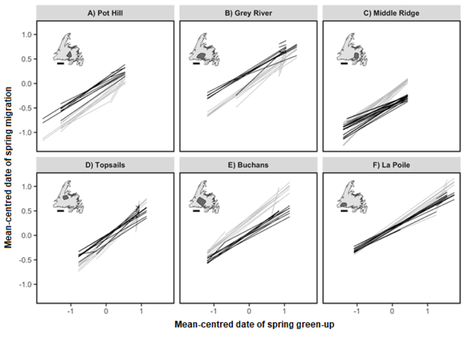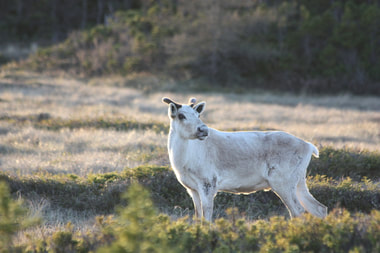Current work
|
Behavioural reaction norms of caribou (Rangifer tarandus) in Newfoundland showing changes in the timing of migration relative to the timing of spring green-up. Each line represents a unique individual. Black lines are dates for departure from winter grounds and grey lines represent arrival on summer grounds.
|
Plasticity in migration timing and repeatability of green wave surfing behaviour of North American ungulates
Changing environments provide both challenges and opportunities for migratory animals. Migration allows herbivores to track changes in high-quality forage resources whose availability changes over the course of spring green-up. The ability of animals to track intra-annual changes in green-up is however contingent upon their ability to acclimate to inter-annual variation in the timing of green-up. Understanding individual plasticity in the timing of migration to spring phenology can inform how individuals and subsequently populations may fare in a changing climate. In addition, quantifying consistent individual differences in migratory behaviour (e.g., is there intra-population consistency in when individuals migrate) will provide insight into whether populations may adapt to climate change due to standing variation in traits related to migration phenology. This research is being undertaken at the University of Wyoming with support from Fulbright Canada. Collaborators: Eric Vander Wal, Jerod Merkle, & Matthew Kauffman |
|
Fogo Island Caribou Ecology Project
The Wildlife Evolutionary Ecology Lab out of Memorial University have recently initiated a long-term study on the caribou on Fogo Island, Newfoundland. The goal is to gain insights into survival, reproduction, vital rates and social dynamics of this isolated population. |
Contact:
Michel Laforge
Department of Zoology and Physiology
University of Wyoming
Biological Sciences 439
1000 E. University Ave.
Laramie, WY
82071
E: [email protected]
T: @MamlSpatialEcol
Michel Laforge
Department of Zoology and Physiology
University of Wyoming
Biological Sciences 439
1000 E. University Ave.
Laramie, WY
82071
E: [email protected]
T: @MamlSpatialEcol


